Abstract
Instantaneous levels of vagal cardiac inhibition reflect integrated responses of vagal motonuclei to multiple sensory neural inputs. We studied how two of these inputs, from trigeminal cutaneous receptors and carotid arterial baroreceptors interact to influence human vagal cardiac outflow. Nine healthy young men voluntarily maintained breathing rates and tidal volumes within narrow limits. Carotid baroreceptors were stimulated with brief periods of moderate neck suction. Volunteers were studied prone, breathing through a snorkel, before and during face immersion in cold water, and before and after an intravenous injection of a very low dose of atropine sulphate (which increases vagal cardiac efferent activity in dogs). Face immersion raised blood pressure slightly, increased heart period, and augmented baroreflex bradycardia and respiratory sinus arrhythmia significantly. Low-dose atropine together with face immersion further augmented blood pressure, heart period, baroreflex responses and sinus arrhythmia. These results suggest that one input to the central nervous system (from trigeminal cutaneous receptors) which increases vagal cardiac outflow, augments vagal responses to another input (from arterial baroreceptors). Since the initial pathways of these two inputs are anatomically separate, it is likely that the influences of respiration and low doses of atropine on vagal motonuclei are exerted down-stream from the termination of primary trigeminal and baroreceptor afferent fibres.
Full text
PDF
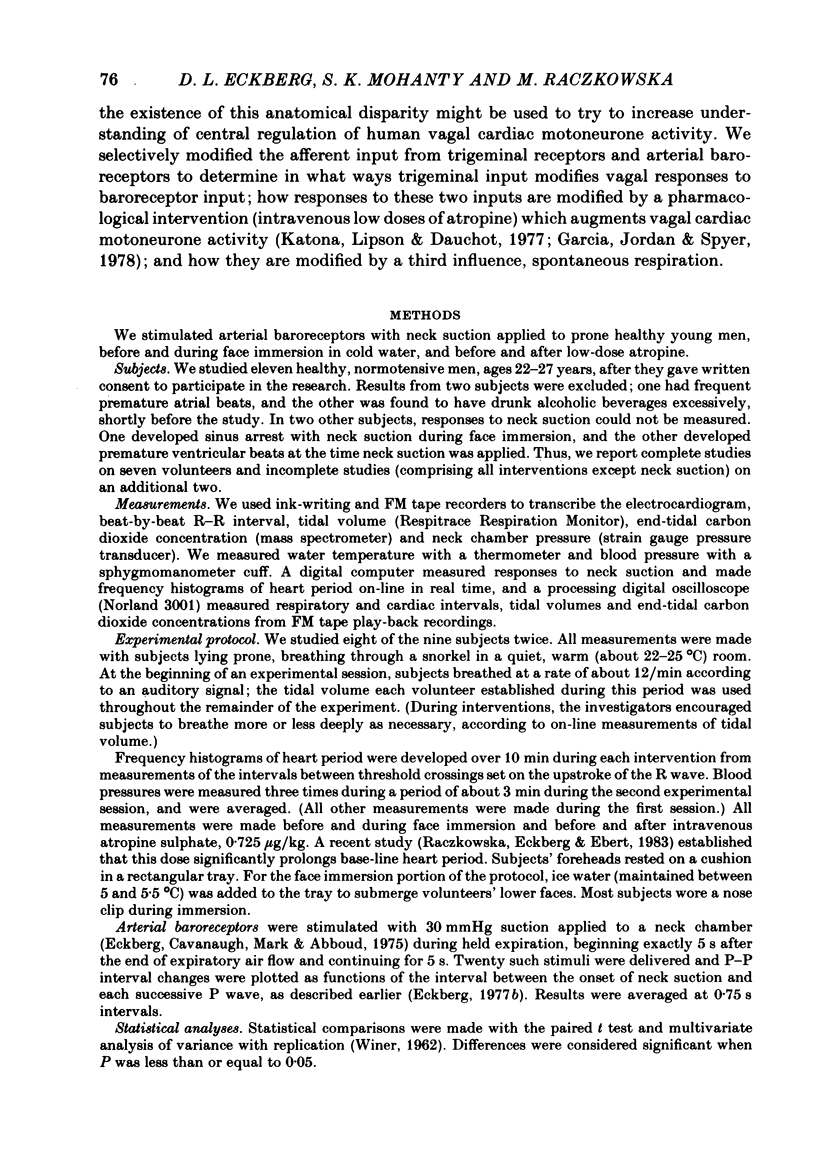

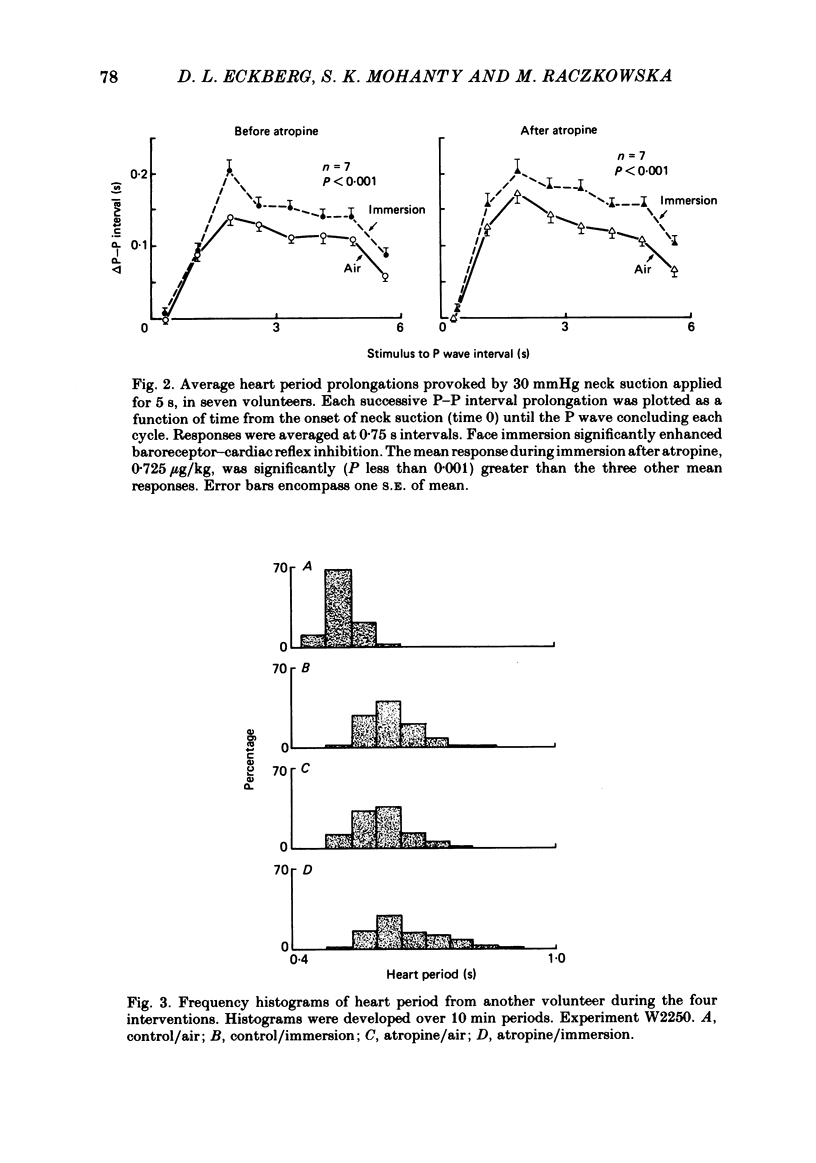
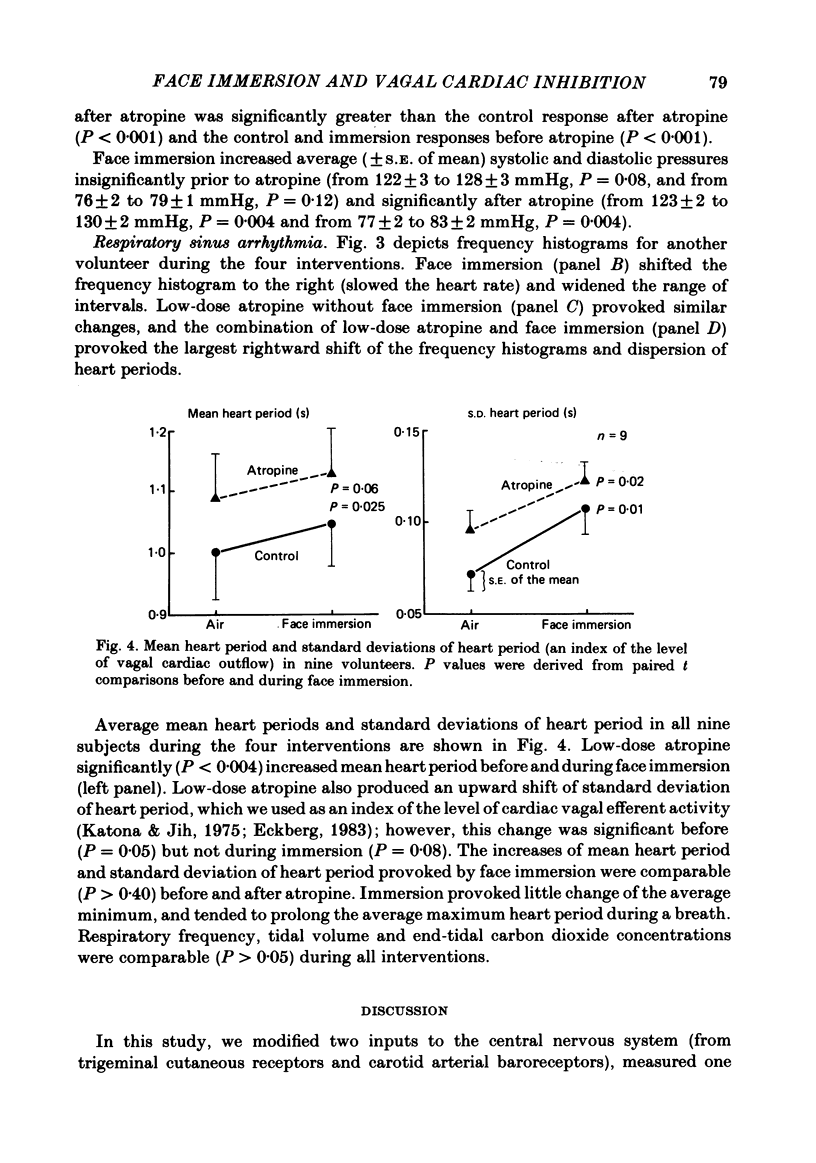
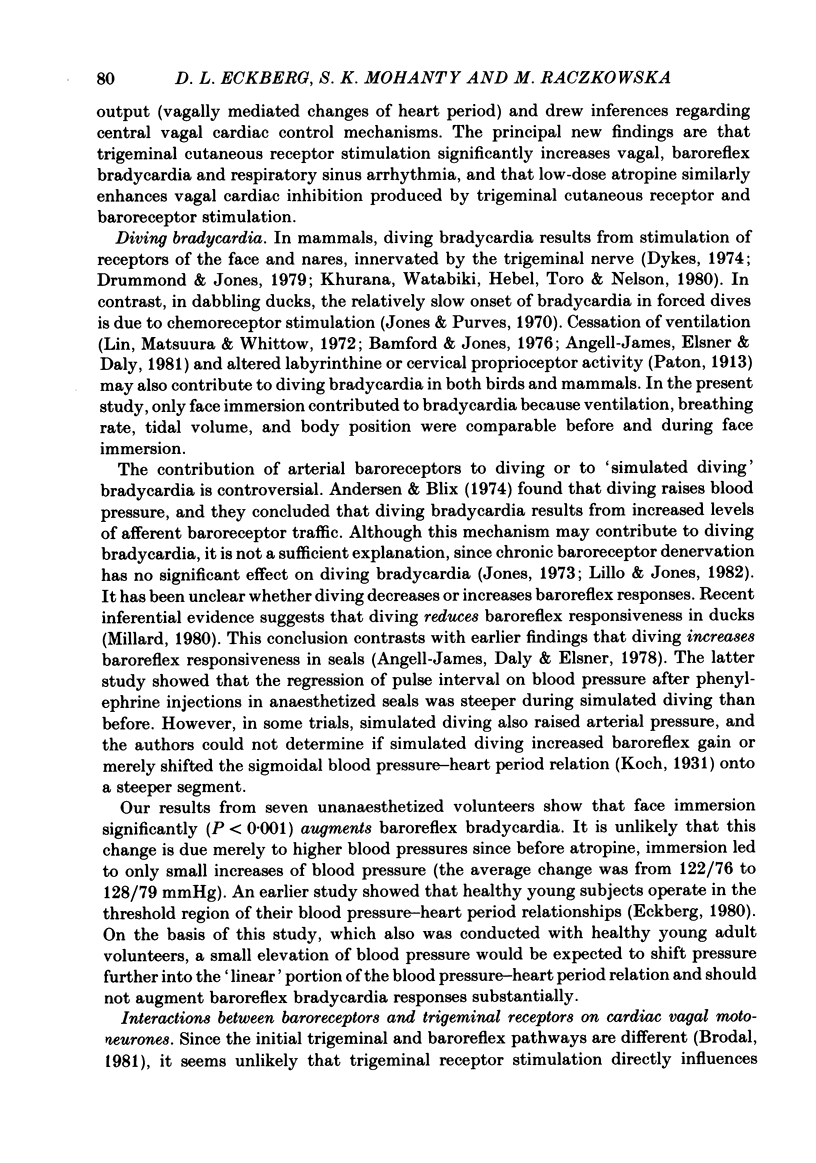
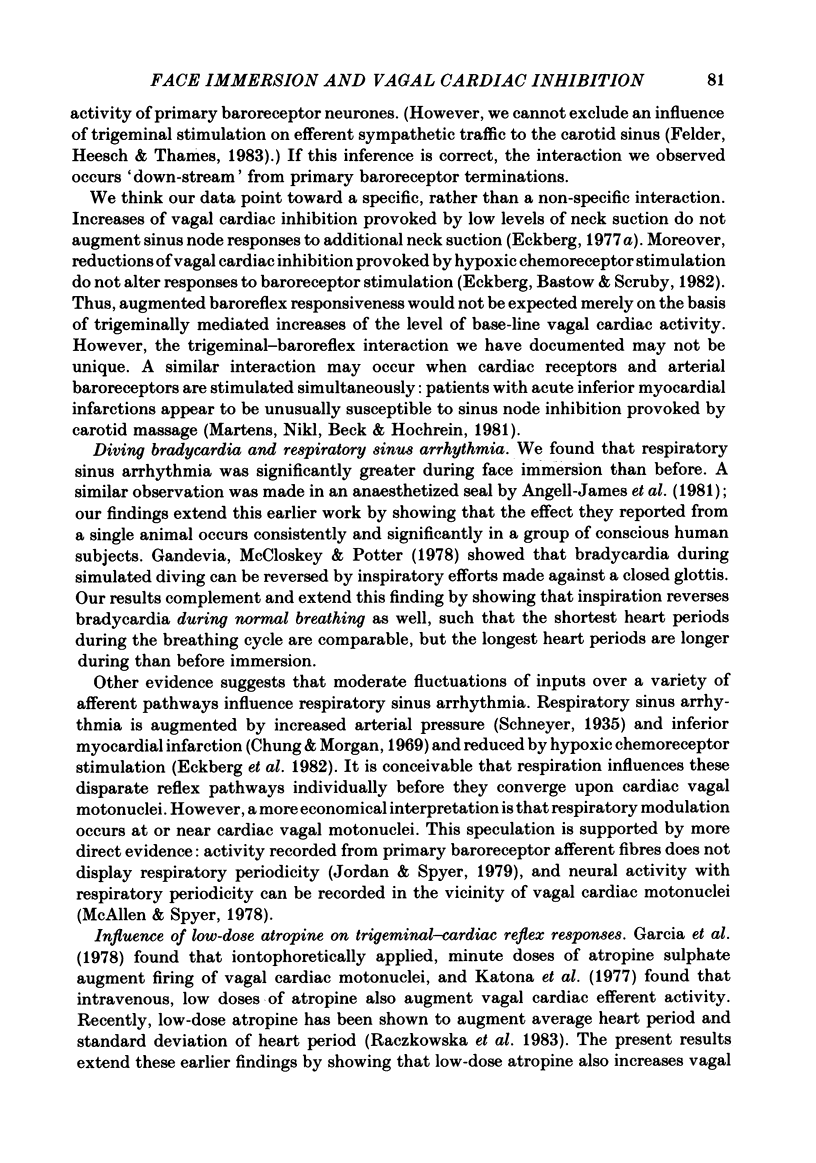
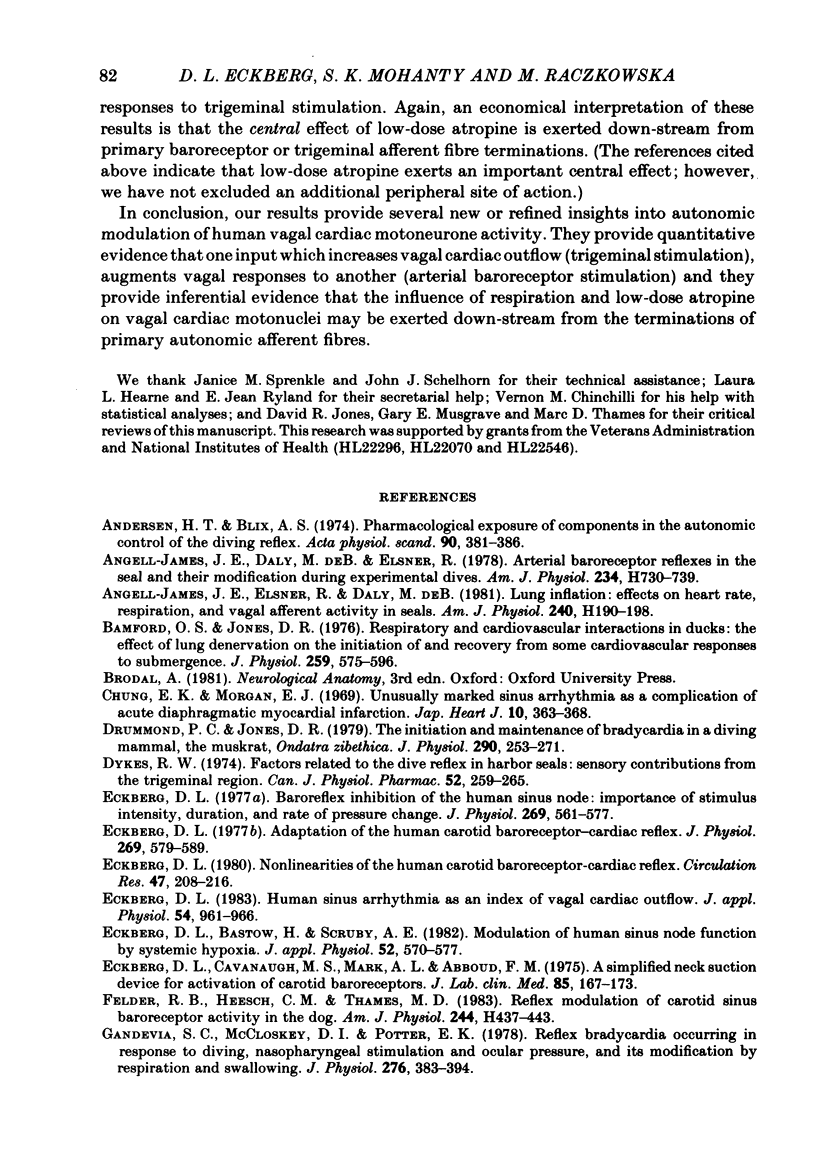
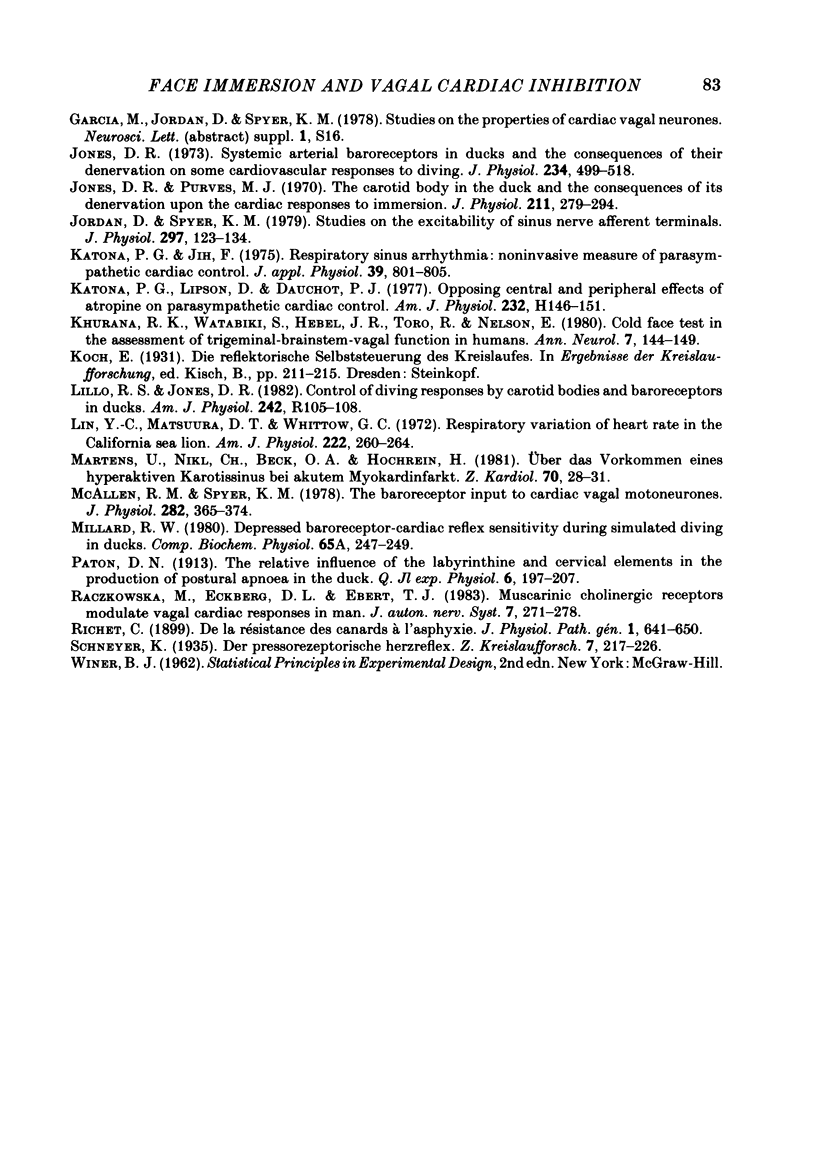
Selected References
These references are in PubMed. This may not be the complete list of references from this article.
- Andersen H. T., Blix A. S. Pharmacological exposure of components in the autonomic control of the diving reflex. Acta Physiol Scand. 1974 Feb;90(2):381–386. doi: 10.1111/j.1748-1716.1974.tb05599.x. [DOI] [PubMed] [Google Scholar]
- Angell-James J. E., Elsner R., De Burgh Daly M. Lung inflation: effects on heart rate, respiration, and vagal afferent activity in seals. Am J Physiol. 1981 Feb;240(2):H190–H198. doi: 10.1152/ajpheart.1981.240.2.H190. [DOI] [PubMed] [Google Scholar]
- Angell-James J. E., de Burgh Daly M., Elsner R. Arterial baroreceptor reflexes in the seal and their modification during experimental dives. Am J Physiol. 1978 Jun;234(6):H730–H739. doi: 10.1152/ajpheart.1978.234.6.H730. [DOI] [PubMed] [Google Scholar]
- Bamford O. S., Jones D. R. Respiratory and cardiovascular interactions in ducks: the effect of lung denervation on the initation of and recovery from some cardiovascular responses to submergence. J Physiol. 1976 Aug;259(3):575–596. doi: 10.1113/jphysiol.1976.sp011484. [DOI] [PMC free article] [PubMed] [Google Scholar]
- Drummond P. C., Jones D. R. The initiation and maintenance of bradycardia in a diving mammal, the muskrat, Ondatra zibethica. J Physiol. 1979 May;290(2):253–271. doi: 10.1113/jphysiol.1979.sp012770. [DOI] [PMC free article] [PubMed] [Google Scholar]
- Dykes R. W. Factors related to the dive reflex in harbor seals: sensory contributions from the trigeminal region. Can J Physiol Pharmacol. 1974 Apr;52(2):259–265. doi: 10.1139/y74-035. [DOI] [PubMed] [Google Scholar]
- Eckberg D. L. Adaptation of the human carotid baroreceptor-cardiac reflex. J Physiol. 1977 Aug;269(3):579–589. doi: 10.1113/jphysiol.1977.sp011916. [DOI] [PMC free article] [PubMed] [Google Scholar]
- Eckberg D. L. Baroreflex inhibition of the human sinus node: importance of stimulus intensity, duration, and rate of pressure change. J Physiol. 1977 Aug;269(3):561–577. doi: 10.1113/jphysiol.1977.sp011915. [DOI] [PMC free article] [PubMed] [Google Scholar]
- Eckberg D. L., Bastow H., 3rd, Scruby A. E. Modulation of human sinus node function by systemic hypoxia. J Appl Physiol Respir Environ Exerc Physiol. 1982 Mar;52(3):570–577. doi: 10.1152/jappl.1982.52.3.570. [DOI] [PubMed] [Google Scholar]
- Eckberg D. L., Cavanaugh M. S., Mark A. L., Abboud F. M. A simplified neck suction device for activation of carotid baroreceptors. J Lab Clin Med. 1975 Jan;85(1):167–173. [PubMed] [Google Scholar]
- Eckberg D. L. Human sinus arrhythmia as an index of vagal cardiac outflow. J Appl Physiol Respir Environ Exerc Physiol. 1983 Apr;54(4):961–966. doi: 10.1152/jappl.1983.54.4.961. [DOI] [PubMed] [Google Scholar]
- Eckberg D. L. Nonlinearities of the human carotid baroreceptor-cardiac reflex. Circ Res. 1980 Aug;47(2):208–216. doi: 10.1161/01.res.47.2.208. [DOI] [PubMed] [Google Scholar]
- Felder R. B., Heesch C. M., Thames M. D. Reflex modulation of carotid sinus baroreceptor activity in the dog. Am J Physiol. 1983 Mar;244(3):H437–H443. doi: 10.1152/ajpheart.1983.244.3.H437. [DOI] [PubMed] [Google Scholar]
- Gandevia S. C., McCloskey D. I., Potter E. K. Reflex bradycardia occurring in response to diving, nasopharyngeal stimulation and ocular pressure, and its modification by respiration and swallowing. J Physiol. 1978 Mar;276:383–394. doi: 10.1113/jphysiol.1978.sp012241. [DOI] [PMC free article] [PubMed] [Google Scholar]
- Jones D. R., Purves M. J. The carotid body in the duck and the consequences of its denervation upon the cardiac responses to immersion. J Physiol. 1970 Dec;211(2):279–294. doi: 10.1113/jphysiol.1970.sp009279. [DOI] [PMC free article] [PubMed] [Google Scholar]
- Jones D. R. Systemic arterial baroreceptors in ducks and the consequences of their denervation on some cardiovascular responses to diving. J Physiol. 1973 Nov;234(3):499–518. doi: 10.1113/jphysiol.1973.sp010357. [DOI] [PMC free article] [PubMed] [Google Scholar]
- Jordan D., Spyer K. M. Studies on the excitability of sinus nerve afferent terminals. J Physiol. 1979 Dec;297(0):123–134. doi: 10.1113/jphysiol.1979.sp013031. [DOI] [PMC free article] [PubMed] [Google Scholar]
- Katona P. G., Jih F. Respiratory sinus arrhythmia: noninvasive measure of parasympathetic cardiac control. J Appl Physiol. 1975 Nov;39(5):801–805. doi: 10.1152/jappl.1975.39.5.801. [DOI] [PubMed] [Google Scholar]
- Katona P. G., Lipson D., Dauchot P. J. Opposing central and peripheral effects of atropine on parasympathetic cardiac control. Am J Physiol. 1977 Feb;232(2):H146–H151. doi: 10.1152/ajpheart.1977.232.2.H146. [DOI] [PubMed] [Google Scholar]
- Khurana R. K., Watabiki S., Hebel J. R., Toro R., Nelson E. Cold face test in the assessment of trigeminal-brainstem-vagal function in humans. Ann Neurol. 1980 Feb;7(2):144–149. doi: 10.1002/ana.410070209. [DOI] [PubMed] [Google Scholar]
- Lillo R. S., Jones D. R. Control of diving responses by carotid bodies and baroreceptors in ducks. Am J Physiol. 1982 Jan;242(1):R105–R108. doi: 10.1152/ajpregu.1982.242.1.R105. [DOI] [PubMed] [Google Scholar]
- Lin Y. C., Matsuura D. T., Whittow G. C. Respiratory variation of heart rate in the California sea lion. Am J Physiol. 1972 Feb;222(2):260–264. doi: 10.1152/ajplegacy.1972.222.2.260. [DOI] [PubMed] [Google Scholar]
- Martens U., Nikl C., Beck O. A., Hochrein H. Uber das Vorkommen eines hyperaktiven Karotissinus bei akutem Myokardinfarkt. Z Kardiol. 1981 Jan;70(1):28–31. [PubMed] [Google Scholar]
- McAllen R. M., Spyer K. M. The baroreceptor input to cardiac vagal motoneurones. J Physiol. 1978 Sep;282:365–374. doi: 10.1113/jphysiol.1978.sp012469. [DOI] [PMC free article] [PubMed] [Google Scholar]
- Raczkowska M., Eckberg D. L., Ebert T. J. Muscarinic cholinergic receptors modulate vagal cardiac responses in man. J Auton Nerv Syst. 1983 Mar-Apr;7(3-4):271–278. doi: 10.1016/0165-1838(83)90080-2. [DOI] [PubMed] [Google Scholar]


